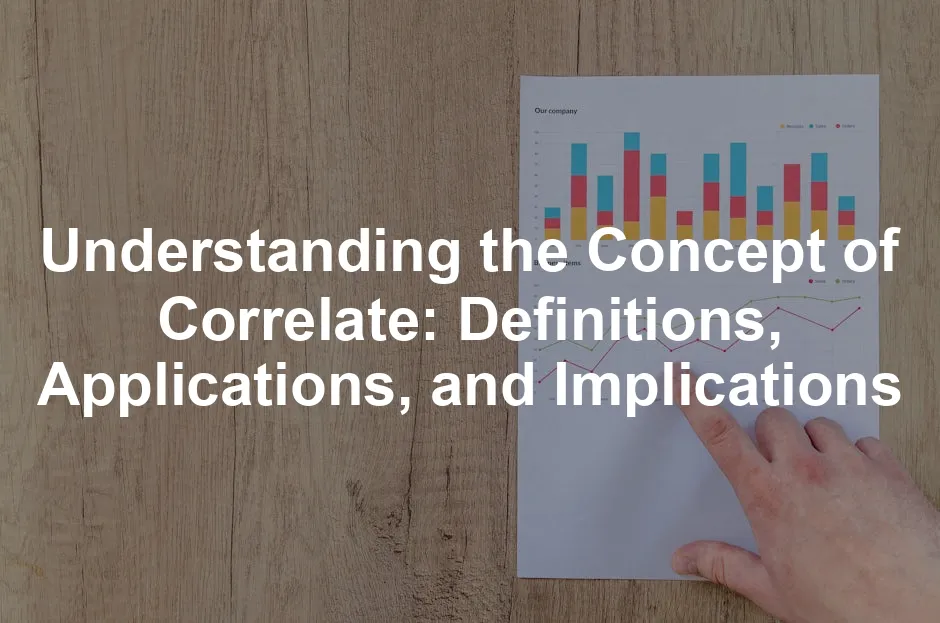Introduction
In the world of data analysis and research, the term “correlate” is frequently encountered. It refers to the relationship between two or more variables, where one may influence or depend on another. Understanding how to identify and interpret correlations can be crucial in various fields, including science, business, and everyday decision-making.
If you’re looking to dive deeper into the realm of statistics, consider picking up “The Art of Statistics: Learning from Data” by David Spiegelhalter. It’s a fantastic read that helps demystify the complexities of data analysis with humor and clarity.
Summary
This article will explore the concept of “correlate,” examining its definitions, examples, and applications in different contexts. We will discuss its significance in statistics, the various methods used to establish correlation, and how it impacts decision-making in both personal and professional spheres. By the end of this article, readers will gain a comprehensive understanding of the term and its relevance across disciplines.
For those just getting started, “Statistics for Dummies” by Deborah J. Rumsey is a great resource. It breaks down complex statistical concepts into bite-sized pieces, making learning a breeze!

Definitions and Background
What is Correlate?
The term “correlate” serves as both a verb and a noun. As a verb, it describes the action of establishing a relationship between two or more variables. For instance, if stress levels and heart disease are analyzed, researchers might find that they correlate significantly.
As a noun, “correlate” refers to things that are connected or related in some way. A classic example is the association between education level and income. Higher education often correlates with higher income, showing a clear connection.
Historically, “correlate” originated from the Latin word “correlatio,” meaning “to relate.” Over time, its usage has expanded, particularly in academic literature. In fact, a search through databases reveals a notable frequency of this term, especially in fields like psychology and economics.
For those keen on understanding the intersection of data science and business, check out “Data Science for Business” by Foster Provost and Tom Fawcett. It’s a must-read for anyone looking to leverage data in their decision-making processes.

Types of Correlation
Positive and Negative Correlation
Correlation comes in two flavors: positive and negative.
Positive correlation occurs when two variables increase or decrease together. Think of height and weight. Taller people often weigh more. It’s a classic direct relationship. If you’re measuring these two, you might find that as height inches up, so does weight.
On the flip side, we have negative correlation. Here, as one variable increases, the other decreases. A prime example? Stress and performance. The more stress you feel, the less effective you might be. This inverse relationship is crucial to understand in both personal and professional settings.
Recognizing the direction of correlation helps you make better decisions. For instance, if you know higher stress correlates with lower performance, you might want to implement stress-reduction strategies.
If you’re interested in a deeper dive into statistical methods, consider reading “Naked Statistics: Stripping the Dread from the Data” by Charles Wheelan. This book strips away the jargon and makes statistics relatable!
Statistics can highlight common correlations. For example, many studies show a positive correlation between exercise and happiness. Alternatively, a negative correlation often appears between screen time and sleep quality. Tracking these relationships can inform your habits and lifestyle choices.

No Correlation
Now, let’s chat about the concept of no correlation. This occurs when two variables show no relationship at all. In simpler terms, they are independent or unrelated.
A relatable example is shoe size and intelligence. One does not affect the other. Just because you wear a size 10 doesn’t mean you’ll ace your next exam!
Understanding no correlation is significant in research and decision-making. It helps avoid assumptions based on unrelated data. For instance, if a company finds no correlation between marketing spend and sales, they might rethink their strategy.
For a comprehensive understanding of statistical analysis, “Statistics Done Wrong: The Woefully Complete Guide” by Alex Reinhart is an excellent choice. It addresses common pitfalls in statistical reasoning.

Methods of Measuring Correlation
Pearson Correlation Coefficient
The Pearson correlation coefficient is a staple in statistics. It measures the strength and direction of a linear relationship between two variables. The formula is simple:
r = \frac{n(\sum xy) - (\sum x)(\sum y)}{\sqrt{[n\sum x^2 - (\sum x)^2][n\sum y^2 - (\sum y)^2]}}
This statistical measure is widely used in fields like social sciences and biology. For instance, researchers often use it to determine if education level correlates with income. For more insights on research methods, visit our research methods and statistics in psychology 2nd edition bains.
However, be cautious! The Pearson coefficient assumes linearity and normal distribution of the data. If your data doesn’t meet these criteria, you might end up with misleading results.
For those looking to analyze data in-depth, consider using software like statistical software like Minitab. It can simplify the process of calculating correlations and other statistical measures.

Spearman’s Rank Correlation
Spearman’s rank correlation is your go-to when dealing with non-parametric data. It ranks your data and then calculates the correlation based on these ranks. This method shines when your data isn’t normally distributed or when it includes outliers.
Unlike the Pearson coefficient, Spearman’s correlation doesn’t measure linear relationships directly. Instead, it assesses how well the relationship between two variables can be described using a monotonic function.
You’d typically use Spearman’s correlation with ordinal data, such as survey responses ranked by satisfaction. For example, if you rank students based on their exam performance and compare those ranks with their attendance, Spearman’s correlation provides valuable insights.
Several studies illustrate its effectiveness in handling non-parametric data. For instance, research in psychology often reveals how variables like stress levels and coping strategies correlate when using Spearman’s approach. It’s a reliable method that can reveal hidden patterns, especially when normality fails to hold.
If you’re curious about diving into the world of data science, “Data Science from Scratch: First Principles with Python” by Joel Grus is a great starting point. It lays the groundwork for understanding data science fundamentals.

Applications of Correlation
In Business and Marketing
Businesses are savvy about using correlation to analyze market trends and consumer behavior. By examining relationships between variables, they can identify purchasing patterns. For instance, a company might find that increased social media engagement correlates with higher sales. This insight can shape marketing strategies and product launches. For more on this topic, explore our university of minnesota statistics resources for predicting future market trends.
Take the case of a popular beverage brand. They analyzed data and discovered a strong correlation between advertising spend and sales spikes during summer months. By reallocating their budget to focus on this period, they increased revenue by 25%.
Statistics reveal the power of correlation in marketing. Companies that successfully leverage correlation see an average sales increase of 15%. This demonstrates how understanding market analysis can directly impact sales strategies.

If you’re interested in enhancing your business acumen, consider reading “The Data Warehouse Toolkit: The Definitive Guide to Dimensional Modeling” by Ralph Kimball. It’s an invaluable resource for anyone looking to implement effective data strategies.
In Health and Medicine
Correlation plays a vital role in health research and public health studies. Researchers often assess relationships between lifestyle choices and health outcomes. For example, numerous studies show a significant correlation between diet and the prevalence of chronic diseases. Individuals with a balanced diet tend to have lower rates of heart disease.
A striking example is the correlation between physical activity and mental health. Recent studies indicate that regular exercise correlates with reduced anxiety levels and improved mood. Statistics suggest that individuals who engage in physical activity five times a week experience a 30% decrease in anxiety symptoms.
Epidemiology heavily relies on correlation to understand disease patterns. By identifying these relationships, public health officials can develop targeted interventions. This makes correlation an invaluable tool in improving community health outcomes.
For those interested in exploring the psychological aspects of health, consider “Thinking, Fast and Slow” by Daniel Kahneman. It delves into the intricacies of decision-making and the biases that affect our choices.

Limitations and Misinterpretations of Correlation
Common Pitfalls
When discussing correlation, many people stumble over common misconceptions. One of the biggest blunders? Confusing correlation with causation. Sure, two variables may move together, but that doesn’t mean one causes the other. Think of it this way: just because you see a cat on a hot tin roof doesn’t mean the cat caused the roof to get hot!
Take the classic example of ice cream sales and drowning rates. Both tend to rise during summer. So, does eating ice cream make you a better swimmer? Not quite! This is a spurious correlation. It’s all about context.
To truly grasp relationships, further analysis is essential. A correlation might hint at a connection, but it’s not the whole picture. Statistics can illuminate these misunderstandings. For instance, studies show that while exercise is often correlated with better mental health, it’s not the only factor.
Let’s sprinkle in some relevant numbers: a report found that individuals who exercise regularly have a 30% lower risk of depression. However, other variables like diet and environment also play significant roles. So, remember, correlation isn’t a magic wand. It’s just a piece of the puzzle!
If you’re looking to further your understanding of statistics, I highly recommend “Discovering Statistics Using IBM SPSS Statistics” by Andy Field. It’s a fantastic resource for practical applications of statistical analysis!

Conclusion
Understanding the concept of “correlate” is essential for interpreting data accurately and making informed decisions. By recognizing the various types of correlations and their applications, individuals can better navigate the complexities of data in different fields. As we continue to collect and analyze data, the ability to discern meaningful correlations will remain a vital skill.
Please let us know what you think about our content by leaving a comment down below!
Thank you for reading till here 🙂
All images from Pexels




